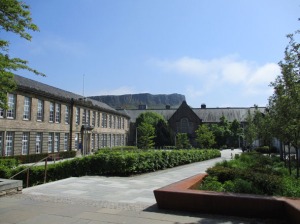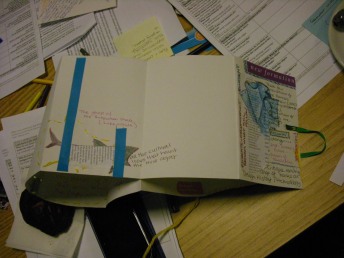One of the reasons that this blog has been fairly quiet over the last few months, is that Fiona English and myself are in the process of co-guest editing two special issues of the Journal of Writing in Creative Practice. We are really excited about the mix of content, which represents a number of genres as well as discuss using genres in teaching and learning. (Of course I will let you know when the issues are actually out, one of them is going to print soon, the other is about to enter the typesetting stage.)
So when we heard that EAP in the North were running a workshop on Exploring Genre(s) specifically in the context of the creative arts, we thought this was an excellent occassion to visit the University of Edinburgh and chat a little bit about our expertise in this and check out what other people are doing.
It was such a lovely event, and I was reminded of our own ReGenre conference last year (indeed, one of the attendees of that event was here giving us an opportunity to catch up), because it was run in a way to allow for lots of sharing and discussion along the way.
Alex Collins from the University of Edinburgh showed us how he engages art history students with core skills via workshops that are backed up with his online Art History Toolkit (check it out here, but be aware that he might ‘wipe’ content in preparation for the new term to then populate it again as the term progresses – though he is currently looking at other ways of running this, and I really do hope it’ll become a permanent resource for all of us to dip into – there is lots of good stuff here, not just for art history students!).
Clare Carr was talking about some of the different genres music students at Durham University are being asked to write in – and wondered whether assignment setters need to be more precise about how they brief and also describe the genres they are actually after. The term ‘essay’ means many things to many people!
This linked in perfectly for an exploration of what an ‘essay’ is or could be – and the Dress-up Doll of Formality exercise I introduced delegates to. After some fast and furious discussion and outfit drawing on the tables, the sharing with solutions of the group was rich (and we are hoping to get the produced images up on the EAP in the North website). This short taste of regenring was a great lead into a quick overview of Fiona’s work – and of course us talking a bit about the forthcoming special issues.
After a short refreshment break, Clare Maxwell was talking about writing genres specifically within Design in her work at the University of Leeds, genres that are very often located in the overlap of academic, vocational and creative work – but sometimes difficult to locate in publications of designers (that old theory/practice divide is still coming up it seems). One of the issues of discussion following on from Clare’s talk was the role of ‘I’ in writing – and the necessity of authors to be aware of what it does.
We then broke off into small groups, where some people had brought ideas to share and discuss. In the group I joined, Anna Rolinska laid out her plans for a Pre-Sessional English for Creative Disicplines course at Glasgow School of Art, which was fascinating, with all of the group then sharing ideas, which hopefully gave Anna some more inspiration. I hope she will write a little post on this later in the year.
Most of us ended up in the pub for a drink and more chat afterwards. On top of everything else, it was a gorgeous day – Thank You to Alison Thomas and her team for organising such a fabulous event!
















